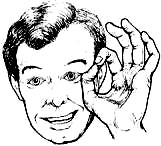Palm Gestures

- Submissive Palm Position - The palm facing up is used as a submissive, non-threatening gesture, reminiscent of the pleading gesture of a street beggar. The person being asked to move the box will not feel that the request is given with pressure and, in a normal superior/subordinate situation, will not feel threatened by the request.
- Dominant Palm Position - When the palm is turned to face downwards, you will have immediate authority. The person to whom you have directed the request feels that he has been given an order to remove the box and may feel antagonistic towards you, depending on your relationship with him. For example, if the person to whom you gave the request was a co-worker of equal status, he could reject your palm-down request and would be more likely to carry out your wish if you had used the palm-up position. If the person to whom you give the request is your subordinate, the palm-down gesture is acceptable, as you have the authority to use it.
- Aggressive Palm Position - The palm is closed into a fist and the pointed finger becomes a symbolic club with which the speaker figuratively beats his listener into submission. The pointed finger is one of the most irritating gestures that a person can use while speaking, particularly when it beats time to the speaker's words. If you are an habitual finger-pointer, try practising the palm-up and palm-down positions and you will find that you create a more relaxed attitude and have a more positive effect on other people.
Shaking Hands

- Glove Handshake - The glove handshake is sometimes called the politician's handshake. The initiator tries to give the receiver the impression that he is trustworthy and honest, but when this technique is used on a person he has just met, it has the reverse effect. The receiver feels suspicious and cautious about the initiator's intentions. The glove should only be used with people to whom the initiator is well-known.
Double Handed Handshakes

- The intention of the double-handed handshake is to show sincerity, trust or depth of feeling towards the receiver. Two significant elements should be noticed. Firstly, the left hand is used to communicate the extra feeling that the initiator wishes to transmit and its extent is related to the distance that the initiator's left hand is moved up the receiver's right arm.
- Elbow Grasp - The elbow grasp, transmits more feeling than the wrist hold, and the shoulder hold.
- In general, the wrist hold and the elbow grasp are acceptable only between close friends or relatives and in these cases, the initiator's left hand penetrates only the receiver's intimate zone.

- The shoulder hold and the upper arm grip enter the receiver's close intimate zone and may involve actual body contact. They should be used only between people who experience a close emotional bond at the time of the handshake.















